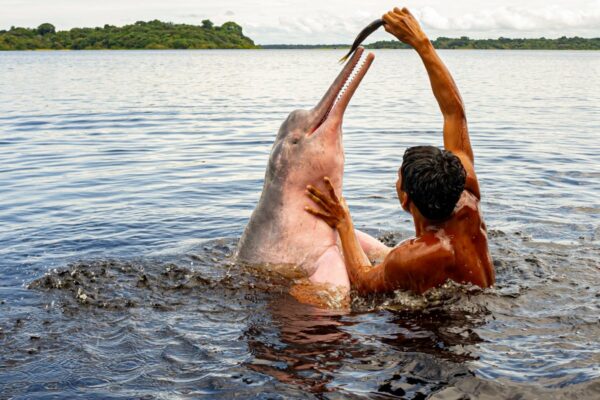Deforestation and other fast-moving changes in the Amazon threaten to turn parts of the rainforest into savanna, devastate wildlife and release billions of tons carbon into the atmosphere, two renowned experts warned Friday.
“The precious Amazon is teetering on the edge of functional destruction and, with it, so are we,” Thomas Lovejoy of George Mason University and Carlos Nobre of the University of Sao Paulo in Brazil, both of whom have studied the world’s largest rainforest for decades, wrote in an editorial in the journal Science Advances. “Today, we stand exactly in a moment of destiny: The tipping point is here, it is now.”
Combined with recent news that the thawing Arctic permafrost may be beginning to fill the atmosphere with greenhouse gases, and that Greenland’s ice sheet is melting at an accelerating pace, it’s the latest hint that important parts of the climate system may be moving toward irreversible changes at a pace that defies earlier predictions.
The speed of the transformation in some key systems, such as Greenland’s ice and the Arctic’s permafrost, has “indeed been underestimated by climate science,” said Stefan Rahmstorf, the head of Earth system analysis at the Potsdam Institute for Climate Impact Research in Germany. “And that’s partly because we cannot really capture them well in our models.”
In interviews, Lovejoy and Nobre said they decided to sound a dire alarm about the Amazon after witnessing the acceleration of troubling trends. The combination of rising temperatures, crippling wildfires and ongoing land clearing for cattle ranching and crops has extended dry seasons, killed off water-sensitive vegetation and created conditions for more fire.
The Amazon is 17 percent deforested, but for the large portion of it inside Brazil, the figure is closer to 20 percent. The fear is that soon there will be so little forest that the trees, which not only soak up enormous quantities of rainwater but also give off mist that aids agriculture and sustains innumerable species, won’t be able to recycle enough rainfall.
At that point, much of the rainforest could decline into a drier savanna ecosystem. Rainfall patterns would change across much of South America. Several hundred billion tons of carbon dioxide could wind up in the atmosphere, worsening climate change. And such a feedback loop would be tough to reverse.
That point of no return, commonly referred to by scientists as a tipping point, “is much closer than we anticipated,” Nobre said in an interview.
The troubling news comes on top of other alarming developments regarding the Earth’s climate.
This month, nearly 100 scientists detailed how the Greenland ice sheet’s losses have accelerated in recent decades, growing from 33 billion tons lost per year in the 1990s to a current average of 254 billion tons annually.
“Greenland is losing ice faster than expected, partly because climate models aren’t good at predicting extreme melting events, but also because many of the ice sheet’s smaller glaciers have started to speed up, too,” said Andrew Shepherd, a glaciologist at the University of Leeds in Britain who led the latest study. “So the [worst]-case scenario now becomes business as usual.”
Separately, a report this month from the National Oceanic and Atmospheric Administration laid out evidence suggesting that the global Arctic already has become a net emitter of carbon dioxide because of the thawing permafrost. That would be a profound shift for a region that includes vast stretches of Alaska, Canada, Siberia and Greenland, and which has long stored massive amounts of carbon in its frozen soil.
At the same time, a global die-off of coral reefs in 2016 and 2017, which included the loss of nearly half of Australia’s Great Barrier Reef, shocked scientists.
“Compared to coral bleaching in 1998 and 2002, the 2016 event was much more extreme – hotter, far more extensive, and deadlier,” said Terry Hughes, an expert on the reef and the director of the ARC Center of Excellence for Coral Reef Studies at James Cook University in Australia. “The reef has changed forever.”
While the speed of the changes involving the Amazon, permafrost and ice sheets has surprised experts, models that scientists created decades ago regarding the average global temperature have largely held true.
The world has experienced about 1 degree Celsius, or 1.8 degrees Fahrenheit, of warming since the late 19th century, largely because of greenhouse gas emissions from human activity.
But much of the Arctic has already warmed by 2 degrees Celsius and some regions even more.
The Amazon also is warming at an accelerated rate. An analysis by The Washington Post of global temperature changes found that almost the entirety of Brazil has warmed by more than 1.5 degrees Celsius, or 2.7 degrees Fahrenheit, since the late 1800s.
Higher temperatures and deforestation are drying out parts of the Amazon and posing a fundamental threat to the rainforest.
In the southern Amazon dry season in particular, temperatures are already 3 degrees Celsius higher than in the 1980s, and the dry season is getting longer, exceeding four months in some regions, Nobre said.
Particularly worrying, he said, is a recent study showing how trees are faring in more than 100 locations across the Amazon. Led by Adriane Esquivel Muelbert of the University of Leeds, researchers found forest transition has begun – trees accustomed to dry conditions are more likely to grow now while trees that require more moisture are disproportionately dying in places where climate changes are the greatest.
Paulo Brando, a tropical ecologist and professor at the University of California at Irvine who has long studied the Amazon, said it is tricky to try to determine the tipping point.
“The definition of ‘tipping point’ can be quite broad,” Brando said, so it is difficult to say whether the Amazon has reached what scientists would call a point of irreversible change. But this much is clear, he added: “We’re not moving away from that tipping point. We’re probably driving very fast toward that direction.”
The impact of changes to the Amazon reach far beyond South America. The rainforest stores an immense amount of carbon in its enormous trees, and if they die, that carbon is released.
In a radically different part of the world, scientists last week described something eerily similar.
Ted Schuur, an expert on northern permafrost at Northern Arizona University, wrote in NOAA’s 2019 Arctic Report Card that recent studies suggest that the thawing of the permafrost – a repository for millennia of dead plant and animal remains – is likely to be contributing carbon dioxide to the atmosphere as those once-frozen materials begin to decompose.
For the “science community at large,” Schuur said in an email, “this is a ‘surprising’ confirmation that the data show the Arctic currently acting as a carbon source.”
Schurr’s reasoning is based heavily on a groundbreaking study led by Susan Natali of the Woods Hole Research Center, research that is in many ways parallel to the new Amazon study. It pools the results from large numbers of scientists across the Arctic to show that in winter, permafrost soils are already emitting a lot of carbon. And those releases are probably enough to offset what happens in the growing season, when Arctic plant growth absorbs carbon.
The models that scientists have used to try to determine how the Arctic region is processing carbon were too conservative when it came to losses in winter in particular, Natali said. As a result, the potential for a transition of the Arctic from a “sink” that takes up carbon to a “source” that emits it may have been underestimated.
“The models, they project that to be happening quite a ways out in the future, but I would say it’s happening now,” Natali said.
Occasional extreme heat events in the Arctic can cause abrupt hillside collapses or “thaw slumps,” which rapidly expose very old and deep permafrost to the open air. Meanwhile, worsening Arctic fires can quickly remove insulating soil and vegetation layers from large stretches of permafrost, suddenly exposing it to the sun.
“It’s like you’re opening the top of a cooler,” Natali said.
In combination, the Amazon and Arctic news underscores that even as humans are largely failing to reduce greenhouse gas emissions, the Earth may increase such emissions yet further.
Still, it is possible to slow the transformation of the Amazon through reforestation, researchers said.
“A tipping point is a way to talk about a moment of system shift or system change,” Lovejoy said. “In this case, it’s not going to be instantaneous, and that’s good news. It allows you to do something about it.”













